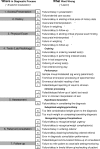Use of health information technology to reduce diagnostic errors
- PMID: 23852973
- PMCID: PMC3786650
- DOI: 10.1136/bmjqs-2013-001884
Use of health information technology to reduce diagnostic errors
Abstract
Background: Health information technology (HIT) systems have the potential to reduce delayed, missed or incorrect diagnoses. We describe and classify the current state of diagnostic HIT and identify future research directions.
Methods: A multi-pronged literature search was conducted using PubMed, Web of Science, backwards and forwards reference searches and contributions from domain experts. We included HIT systems evaluated in clinical and experimental settings as well as previous reviews, and excluded radiology computer-aided diagnosis, monitor alerts and alarms, and studies focused on disease staging and prognosis. Articles were organised within a conceptual framework of the diagnostic process and areas requiring further investigation were identified.
Results: HIT approaches, tools and algorithms were identified and organised into 10 categories related to those assisting: (1) information gathering; (2) information organisation and display; (3) differential diagnosis generation; (4) weighing of diagnoses; (5) generation of diagnostic plan; (6) access to diagnostic reference information; (7) facilitating follow-up; (8) screening for early detection in asymptomatic patients; (9) collaborative diagnosis; and (10) facilitating diagnostic feedback to clinicians. We found many studies characterising potential interventions, but relatively few evaluating the interventions in actual clinical settings and even fewer demonstrating clinical impact.
Conclusions: Diagnostic HIT research is still in its early stages with few demonstrations of measurable clinical impact. Future efforts need to focus on: (1) improving methods and criteria for measurement of the diagnostic process using electronic data; (2) better usability and interfaces in electronic health records; (3) more meaningful incorporation of evidence-based diagnostic protocols within clinical workflows; and (4) systematic feedback of diagnostic performance.
Keywords: Diagnostic errors; clinical decision support systems; clinical informatics; health information technology; patient safety.
Figures



References
-
- Schiff GD, Kim S, Abrams R, et al. Diagnosing Diagnosis Errors: Lessons from a Multi-institutional Collaborative Project and Methodology. 2005 - PubMed
-
- Berner ES, Graber ML. Overconfidence as a cause of diagnostic error in medicine. Am J Med 2008;121(5 Suppl Diagnostic Error in Medicine):S2–23 - PubMed
-
- Newman-Toker DE, Pronovost PJ. Diagnostic errors: the next frontier for patient safety. JAMA 2009;301:1060–2 - PubMed
-
- Schwartz WB. Medicine and the computer. N Engl J Med 1970;283:1257–64 - PubMed
-
- Schwartz WB, Patil RS, Szolovits P. Artificial intelligence in medicine. Where do we stand? N Engl J Med 1987;316: 685–8 - PubMed
Publication types
MeSH terms
LinkOut - more resources
Full Text Sources
Other Literature Sources
